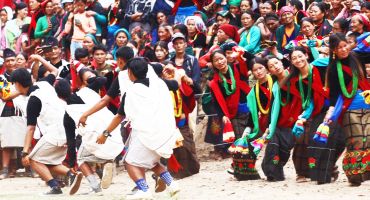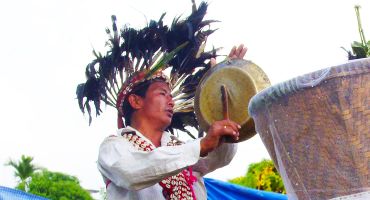The folk music of the Limbus is central to understanding their cultural elements, including their worldview, relationships, traditions, roles, and practices. For centuries, folk music has long been a traditional method of entertainment, but in the Himalayan region, it also encompasses mythical storytelling and the performance of rituals. Traditional music genres of the Limbu people include all of these components.
Much like that of other Himalayan indigenous communities, Limbu tribal music is traditionally vocal. Limbu folk songs are accompanied by performance and ceremony, which usually take place without written prompts, but they come from various generations of practiced and perfected interactions.` This autochthonous folk music also reflects the depth of the cultural concepts that exist within the tribe. It displays kinship structures, relationships, ritualistic beliefs, creation myths, and the creative function for relationships with physical and spiritual beings. Today, the Limbu community is utilizing and recreating their traditional culture with music as a medium of entertainment, which helps preserve ancient traditions in the modern age.
Ethnic Limbu folksongs are called Samlo. There are a variety of folksong genres, but Palam Samlo always tops the Limbu repertoire. Palam is sung while doing chores, working in the fields, or during social events like weddings and festivals. But it is associated the most with Yalang (Paddy Dance). It is a commonly held notion that after harvest, the people would gather at a particular house. Here they held hands, formed a circle, and went around while stamping upon the paddy to extract rice grains. This dance would later be accompanied by songs that ultimately became Palam.

For an open-eared listener, traditional Limbu music is not difficult to enjoy. Even if you do not understand the language, repeated hearings of these songs will gradually reveal the subdued, haunting melody enfolded in their carefully tuned forms. At its core, traditional Limbu songs serve as repositories and disseminators of lifestyle, knowledge, and traditions. Limbu folksong genres such as Palam, Sarek, and Khayali, while being traditionally recreational, also depict social life, and emphasize a balance of intellectual, emotional, and spiritual processes.
Limbu people categorize the Palam genre into four forms or moods. There is one that denotes flirtation and courting in the form of riddles. The second form is about love in its purest essence. The third form represents love and proposal for marriage. The fourth one describes human life as flowers. This assists young men and women to subtly declare that their destiny is to realize emotions and love. The essence of Palam is to exchange feelings of love and affection and experience pain and pleasure through a heart-touching song, sung in harmony.
Palam Samlo, initially intended as paddy dance, has become incredibly popular over the years. Limbu traditional songs, which are centuries-old, still bring the community together for social activities or ceremonies. But in time, there have been changes in its form and tempo. Palam has now been divided into Sakpa Palam, played with a faster beat, and the Khemba Palam, on a slower beat. As Limbu society evolved, their music has diversified into various genres that bear both social and religious contexts.
Khayali is another popular genre among the Limbus. It is a duet that is a casual exchange between male and female vocalists. These songs are dialogues, witty repartees between two singers. In Khayali or Palam, the meter remains constant within the tune. Its rhythm, which uses syncopation, is usually relatively uncomplicated. There is extended use of vibrato. In many instances, the instruments are dominated by vocals. This occurs because the lyrics and emotions become larger than the music itself. The form is generally strophic where each stanza is sung over the same music. Strophic forms in music exist because they are iterative. These are songs that consist of short sections of music that have been repeated countless times throughout history.

Many other types of Limbu folksongs exhibit their daily activities. These are songs that have been transferred from one generation to another. There are wedding and farming songs that help deconstruct the parameters that define their society. All genres of Limbu folk music present a different understanding of their lifestyle. Where there are general folksongs, we can also find numerous ritual song genres among the Limbu people. These are a part of Limbu Mundhum (oral narrative) and always accompany life-cycle rituals. Limbus has always ascribed spiritual importance to these rituals through their songs.
According to various sources, apart from Palam and Khayali Limbus classify their song (samlo) genres into the following:
Hakpare – Spiritual song sung only by women.
Namdatte Kehsam – Wedding Song
Domke Akma – Sung while working
Thakptham – Sung while moving into a new house
Nisammang Sewa – Devotional song accompanied by performance
Mingwan – Ritual song while naming a new-born
Tamkye – Sung while cultivating the fields
Agnekwa Sammet – Lullaby
Limbu folksongs demonstrate that music plays a fundamental role in influencing, defining, and maintaining tribal cultures. Renowned Limbu folk singers continue to emerge with artistic collaborations to create space for identity building through indigenous music. So while other forms of culture may be challenging to preserve, Limbu folksongs are still popular and perhaps will be able to maintain and balance their cultural constructs through traditional music.





[…] group has their way of expression and lifestyle and music plays an important role in their life. Traditional folk music represents various ceremonies and events in the lifetime demonstrating their unique […]